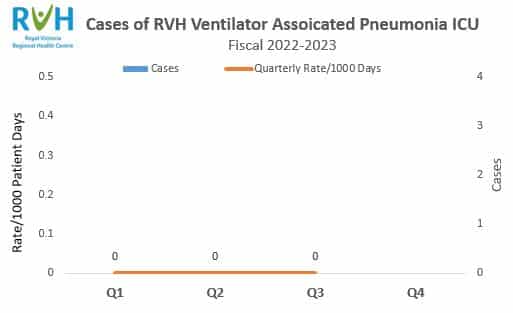What is a Ventilator Associated Pneumonia (VAP)?
For our public reporting purposes, ventilator associated pneumonia (VAP) is defined as a pneumonia (lung infection) occurring in patients in an intensive care unit (ICU), requiring, external mechanical breathing support (a ventilator) intermittently or continuously, through a breathing tube for more than 48 hours.
Ventilator associated pneumonia can develop in patients for many reasons. Because they are relying on an external machine to breath, their normal coughing, yawning, and deep breath reflexes are suppressed. Furthermore, they may have a depressed immune system, making them more vulnerable to infection. ICU teams have many ways to try to assist patients with these normal breathing reflexes, but despite this, patients are still at risk for developing pneumonia.
Sometimes when patients are admitted to the hospital, they can get infections. These are called health care-associated infections.
Why focus on VAP?
The public reporting of our VAP cases is not intended to serve as a measure for hospitals to compare themselves against other organizations, or for the public to use as a measure of where to seek care. A high number of VAP in a quarterly period does not necessarily mean that a hospital is “unsafe”. That is why it is vital that the rates are viewed in the context of other performance indicators. That said, the analysis of our VAP cases rates over time will certainly provide the Royal Victoria Hospital with helpful information that we can use to make quality improvements in our organization.
Public reporting of our hospital’s VAP cases will allow the Royal Victoria Regional Health Centre to establish a baseline from which we can then track our rates over time. If we feel our rates have risen above our baseline, we can look internally at our hospital’s processes, identify areas for improvement, and implement strategies to reduce the incidence of these infections in our organization.
Publicly reporting on VAP and other indicators is another, helpful measure to ensure the care provided to our patients is even safer, and improves over time.

| Q1 | Q2 | Q3 | Q4 | |
| VAP Cases | 0 | 0 | 0 | |
| Quarterly Rates/1000 Days | 0 | 0 | 0 |
How is the VAP Indicator Calculated?
All hospitals with ICUs required to report into the Critical Care Information System (CCIS) – a centralized data collection system where hospitals report a variety of critical care information – must publicly report the VAP indicator data. Only hospitals with an ICU that ventilate patients for more than 48 hours are publicly reporting their VAP cases. This is because by definition, VAP does not occur in patients who have been ventilated for shorter periods of time. These hospitals are considered “eligible” for VAP reporting.
These Ontario hospitals are posting their quarterly VAP rate and case count for those infections acquired in their facility, using the following formula:
total # of ICU cases of VAP after 48 hours of mechanical ventilation x 1000
total # of ventilator days for ICU patients 18 years and older
What can patients do to help reduce their chances of infection?
Frequent hand cleaning is a good way to prevent the spread of infection. Hand hygiene involves everyone in the hospital, including patients.

